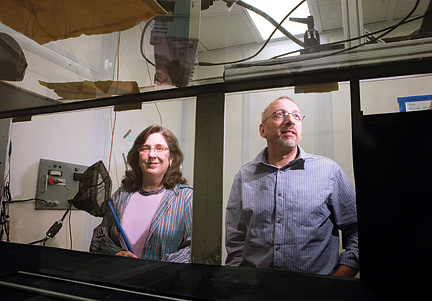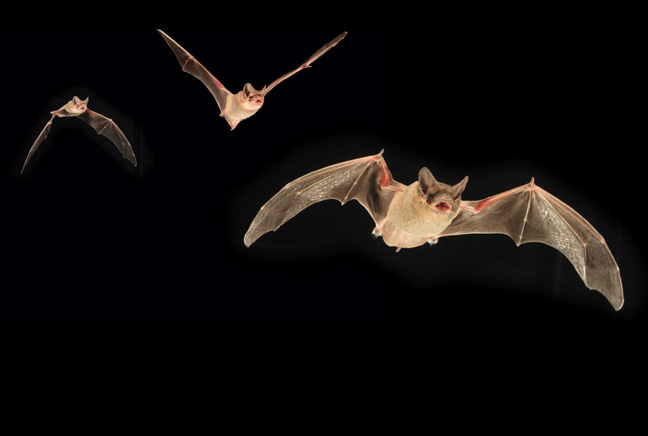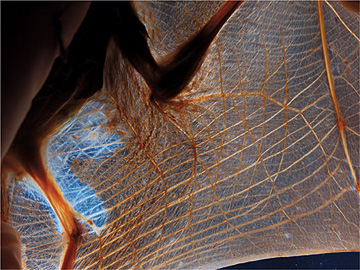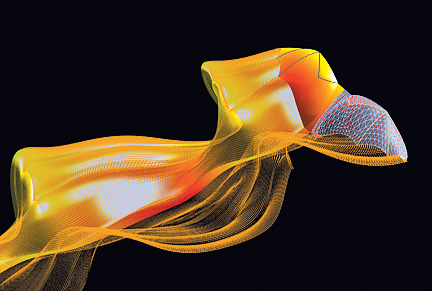The chamber in the basement of Hunter Lab is nearly pitch-black as a lab assistant lets loose a bat. The animal—Eptesicus fuscus, or the Big Brown Bat—flies in figure eights, dodging chains dangling from the ceiling. Outside the chamber, Jonathan Barchi, a neuroscience graduate student, looks at a monitor divided into four quadrants, each showing images from one of the infrared cameras inside the room where the bat is performing its rapid acrobatic flight.

Barchi wants to know whether bats can have memories of where they've been, and if so, how long they last. This particular study began several months ago, when these same bats were released daily in this chamber, or Bat Cave, as it has become known. After several weeks of this routine, Barchi gave the bats a break of more than a month, and has recently brought them back to observe how much they remembered about navigating the Bat Cave. By analyzing the images of their flight, Barchi has found that the bats not only remember their environment; they may also create and retain mental images of spaces. If this is true, bats are far more intelligent than we've suspected.
Bats have become an important study animal for biologists and engineers at Brown. Barchi, for instance, works in the lab of neuroscientist and professor of biology Jim Simmons, whose goal for the last four decades has been to understand the mind of the bat: how it thinks, how fast it works, how it makes sense of the world, and how it remembers. And Simmons is just one of several prominent bat researchers at the University, which has emerged as one of the country's major hubs of bat research. In addition to Simmons, Sharon Swartz, a biology professor in the department of ecology and evolutionary biology, and Kenny Breuer '82, a professor of engineering, also work on bats, collaborating to study how their wings function and are structured. In addition, about a dozen graduate students research everything from bats' calls and brain waves to the function of the microscopic hairs on their wings.

From an evolutionary standpoint, bats are among natural selection's most successful animals. Twenty percent of all mammals are bats. Not only have they survived, they thrive everywhere on the planet except the north and south poles. Perhaps the greatest reason for their success is the way they fly. To watch bats do this in slow motion is to appreciate ballerinas gracefully performing turns and twists in the air. Bats can do somersaults and cartwheels. They can fly as fast as thirty miles an hour. They can perform a high-speed 180-degree turn with three flaps of their wings. A million bats can fly out of a cave at once, yet few of them will bump into one another. Because mother bats nurse their offspring until they are nearly full-size, their wings must be powerful enough to lift 25 to 50 percent of their body weight.
Bats get around using a sonar system far more complex than any invented by humans. If the tiny shrieks they emit as they fly were at a frequency detectable by the human ear, they would sound like a blaring fire alarm next to your head. The shrieks echo off objects and bounce back to the bat, enabling it to detect surrounding objects as far away as sixty feet or as close as half a millimeter.Sharon Swartz is an affable, warm, and genial woman with graying brown hair, big blue eyes, and an oval face. Her office is decorated with bats: stuffed toy bats, bat cutouts, and bat toys that dangle from wires. She says that as a child she had no interest in science, much less in bats, and went to college thinking she'd become a doctor. But the biology and anthropology classes she took while an undergrad at Oberlin changed all that. The first animals she studied were primates, and her PhD thesis at the University of Chicago focused on the design of the forelimb of such lesser apes as siamangs and other gibbons.

Kenny Breuer arrived at Brown in 1999, nine years after Swartz. He grew up in England, but moved to the United States with his family as a teenager and has lived here ever since. Bats were not his first interest either. With a PhD from MIT in aeronautics and astronautics, Breuer was an expert in fluid mechanics, a field of applied engineering and physics that studies the tricky question of how fluids move. Swartz says fluid mechanics is "for the mathematically fearless," and that quality was what prompted her to ask Breuer to meet over coffee and talk about bat research.
"I thought she was crazy," Breuer says. "I had never been interested in animal flight."
After more discussions, he began to see the bat's appeal. What if he could come up with a model to explain bat flight? He became interested in how the shape and properties of the bat's wing enable it to maneuver so deftly. How do air currents affect the bat's speed and the angle of its wings? He decided to take on the challenge of using mathematics to create a physical model of a bat's wings and then build an actual replica that mimics aspects of its complexity: a robotic bat.
Breuer's office is decorated with models of the Space Shuttle and toy airplanes. A poster of the Wright Flyer hangs on his wall. He hopes that understanding bat flight will eventually pave the way to building a new kind of flying machine, one whose wings might have at least some of the flexibility of a bat's. Over the years, Breuer and Swartz have achieved a number of significant advances in our understanding of the bat's wing. Bat wings are not like a bird's or an insect's. They are far more flexible. In fact, a bat wing has the same bone structure as a human hand. A nub halfway down the wing serves as the thumb. Four bones running the length of the wing act as the other fingers. And, just as in the human hand, there are joints throughout the wing, enabling individual bones to bend, pivot, and twist independently of one another.
A bat can fold its wing in half and can angle it to adjust for wind currents in a way not possible for a bird or an insect. The skin on the wing is highly flexible, too. It can stretch to double its length. It can billow like a sail, thus reducing the amount of work the bat needs to do when taking off or gaining altitude. Swartz describes the skin as feeling soft and "membraney." It is thin enough for light to pass through.Some of Swartz's work has focused on the thousands of microscopic hairs that lie atop the skin on the wing. Swartz says what they do or how they work is not entirely clear, but they appear to make up an elaborate sensor network that enables the bat to feel changes in wind currents.
Swartz and Breuer study bat flight using a fifteen-foot-long rectangular wind tunnel, into which they pump air up to fifteen miles an hour. With the bat flying in place, high-speed cameras film its movements, allowing the researchers to study wing movements down to a fraction of a second. The tunnel can also be filled with nontoxic aerosol particles while the bat is suspended in flight; the wings carve out patterns in the mist, leaving a wake that digital cameras can record.
In 2007, Swartz and Breuer mapped out the first high-resolution, three-dimensional models of the bat's wake fields. They showed that on the down stroke, bats keep their wings extended and curved like a sail to harness maximum wind power. On the up stroke the bats fold their wings close to their bodies, most likely to reduce drag.
Two years ago, Joe Bahlman, a graduate student in engineering and biology who works with Breuer and Swartz, set out to construct a robotic bat wing. He first used gears and a crankshaft connected to a motor to move the wing, but found it "too limiting," he says. He searched for a "more biologically inspired model."
The new wing, completed only last December, employs three motors pulling and pushing six cables to flap an eight-inch-long plastic wing skeleton. The wing has a shoulder that can move up and down and forward and back like the wing of a real bat. Joints in the wing's bones allow it to retract and open. Its major limitation is that the wing can't change its pitch, something bats routinely accomplish. As for the skin, Bahlman modified a silicon-based organic compound that is stretchy and thin enough to approximate the skin on an actual bat wing. The contraption doesn't begin to approximate the complexity of bat flight—that's "beyond the ability of any supercomputer we have," Swartz says —but it is still a significant step forward.

Neuroscientist Jim Simmons looks very much as you'd expect an academic to look: scraggly white beard; glasses with thin, round titanium frames; and unkempt hair that can sometimes stick out in all directions. He talks in rapid-fire bursts, shooting out big ideas here and there and expecting you to be able to follow. His office is littered with boxes, folders, and mechanical equipment.
Simmons got into bats while he was in graduate school at Princeton in the 1960s. At the time, he was working in a lab studying the hearing of lizards, frogs, and fish. When the researcher running the bat lab left, Simmons thought, "What the heck? Great, I'll just take this over." He began by studying bat hearing, which at the time was a neglected area of research. His quest ever since has been to understand how bats "see" with their ears. Several types of bats have very good eyesight, but it doesn't do them much good when they're flying at night. Instead, they rely on their ears to pick up the echoes of their cries bouncing off the objects around them, a technique known as echolocation. Based on how long it takes for the echo to come back and which ear it strikes first, bats get an amazingly accurate sense of their environment.
According to Simmons, bats use echolocation to generate a three-dimensional map of their surroundings. The auditory inputs trigger a visual model allowing the bats to, in effect, see with their brains. Simmons hopes one day to know exactly what the world looks like to a bat—how it thinks through the images its mind generates—but first he must understand how its amazingly complex sonar system works.
In the late 1980s, Simmons performed a series of experiments on bats to gauge how the animals sort through the echoes bombarding them after they emit a call. After constructing a Y-shaped platform about six feet long, he set up audio gear at either end of the letter's top branches and placed a bat at the base of the platform. The devices received the bats' cries, produced the echoes, and then returned them to the bats. With a mealworm reward, the bat was trained to move toward the echo.
Echoes bombarded the bat from both branches of the Y, but the sounds from one were emitted a tiny fraction later than the other. The researchers wanted to see if the bat would head in one direction, and then change course when the second echo reached it from the other branch. If the bat didn't change course, it would mean the delay between the two echoes was too short for the bat to distinguish between them and so was hearing them as a single echo.

"They all thought we were crazy," he says.
Just a few years ago, though, Simmons's lab began taking a closer look at the cells that control hearing in a bat's brain. Through careful microscopic examination, Simmons and assistant research professor of neuroscience Seth Horowitz '93 ScM, '97 PhD detected traces of a protein called connexin 36 in the connections between these brain cells. In mammals, connexin 36 indicates that the brain cells communicate via electric charges. But bats weren't thought to have electrical synapses between neurons; the bridge, it was believed, was chemical.
Because electrical wiring in the brain works much faster than chemical connections, Horowitz's work may explain Simmons's finding from a decade earlier. More research needs to be done, but it's entirely possible that Simmons is on his way to being vindicated.
In recent years, brain researchers have been focusing more and more on the electrical synapses in human brains. The majority of our brain connections are chemical, but in regions that need to perform such quick tasks as controlling reflexes, electrical synapses are also present. Simmons hypothesizes that these electrical synapses may be far more common in the human brain than we have so far realized. It is possible that a still-undetected substratum of nerve connections in our brains is performing tasks in a way we have not yet detected, and it may be operating at speeds much faster than we've estimated. So far, this is merely conjecture, but Simmons's hunches have a way of turning out to be right. We may be more like bats than we've ever imagined.
"I would have thought that I would have gotten sick of bats long ago," says Swartz. "But I find that the longer I study bats, the more questions I have."





